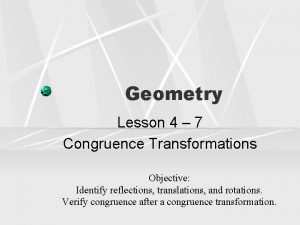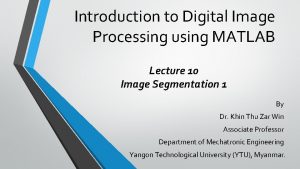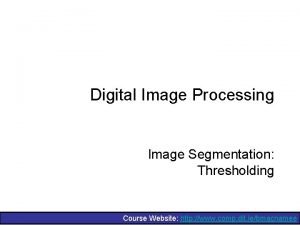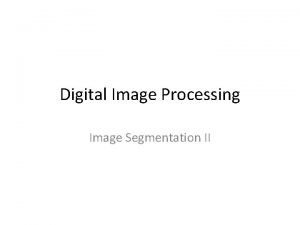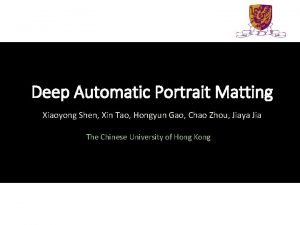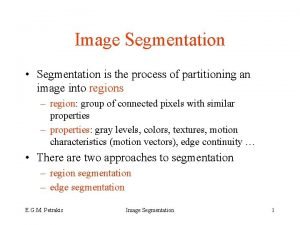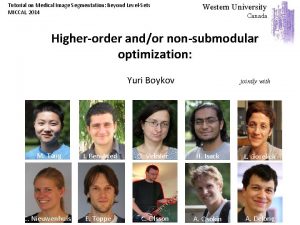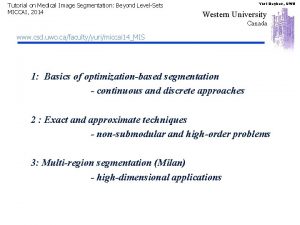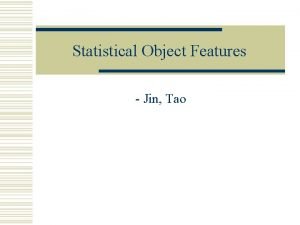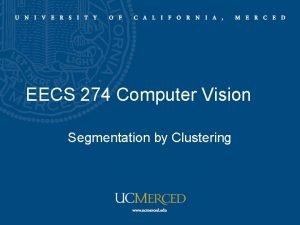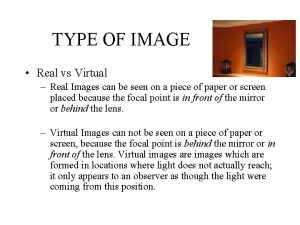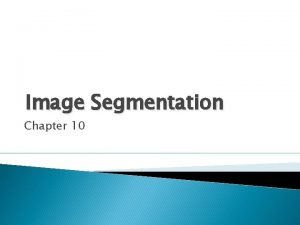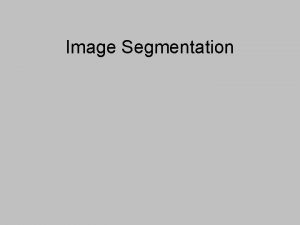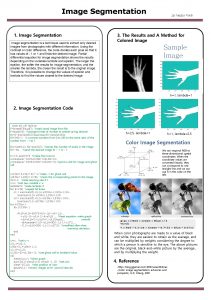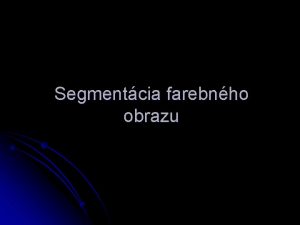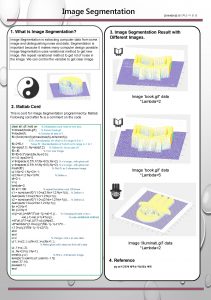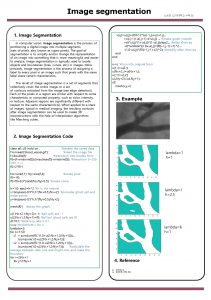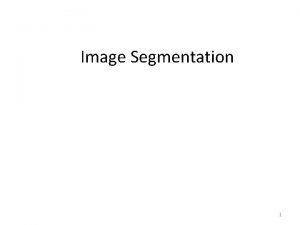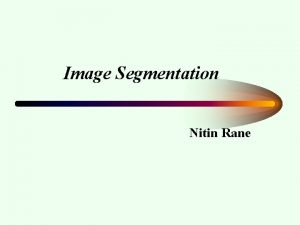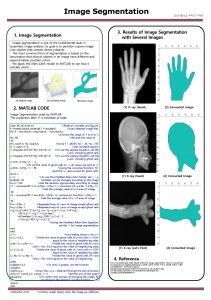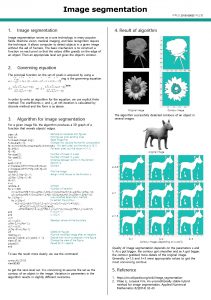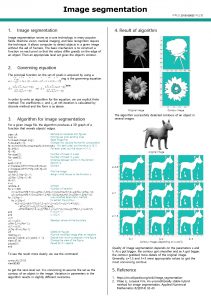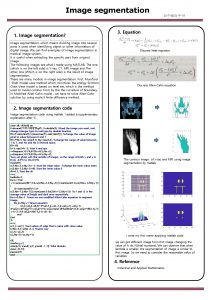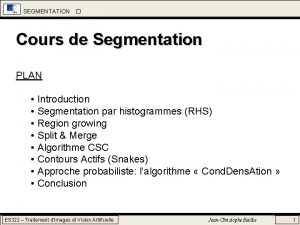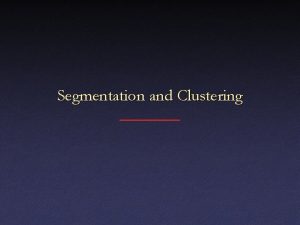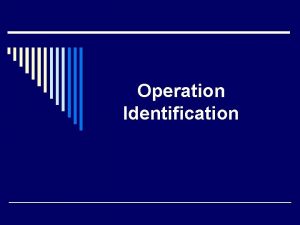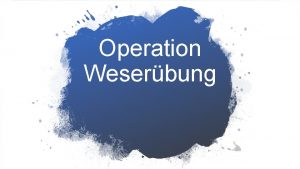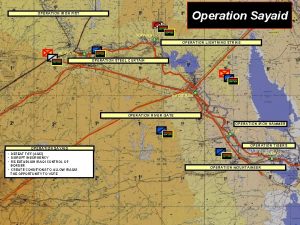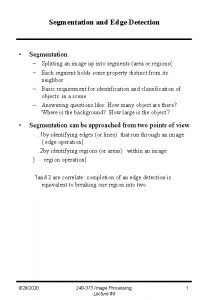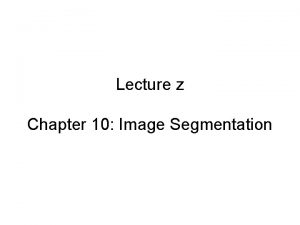Image Segmentation Image segmentation is the operation of























































- Slides: 55

Image Segmentation Image segmentation is the operation of partitioning an image into a collection of connected sets of pixels. 1. into regions, which usually cover the image 2. into linear structures, such as - line segments - curve segments 3. into 2 D shapes, such as - circles - ellipses - ribbons (long, symmetric regions) 1

Example 1: Regions 2

Example 2: Straight Lines 3

Example 3: Lines and Circular Arcs 4

Region Segmentation: Segmentation Criteria From Pavlidis A segmentation is a partition of an image I into a set of regions S satisfying: 1. Si = S 2. Si Sj = , i j 3. Si, P(Si) = true 4. P(Si Sj) = false, i j, Si adjacent Sj Partition covers the whole image. No regions intersect. Homogeneity predicate is satisfied by each region. Union of adjacent regions does not satisfy it. 5

So So all we have to do is define and implement the similarity predicate. But, what do we want to be similar in each region? Is there any property that will cause the regions to be meaningful objects? 6

Main Methods of Region Segmentation 1. Region Growing 2. Clustering 3. Split and Merge 7

Region Growing Region growing techniques start with one pixel of a potential region and try to grow it by adding adjacent pixels till the pixels being compared are too disimilar. • The first pixel selected can be just the first unlabeled pixel in the image or a set of seed pixels can be chosen from the image. • Usually a statistical test is used to decide which pixels can be added to a region. 8

The RGGROW Algorithm • Let R be the N pixel region so far and P be a neighboring pixel with gray tone y. 2 • Define the mean X and scatter S (sample variance) by X = 1/N I(r, c) R 2 2 S = 1/N (I(r, c) - X) (r, c) R 9

The RGGROW Statistical Test The T statistic is defined by T= (N-1) * N 2 2 ------- (y - X) / S (N+1) 1/2 It has a T N-1 distribution if all the pixels in R and the test pixel y are independent and identically distributed normals (IID assumption). 10

Decision and Update • For the T distribution, statistical tables give us the probability Pr(T t) for a given degrees of freedom and a confidence level. From this, pick suitable threshold t. • If the computed T t for desired confidence level, add y to region R and update X and S 2. • If T is too high, the value y is not likely to have arisen from the population of pixels in R. Start a new region. 11

RGGROW Example image Not great! segmentation What do you think this would do on wallpaper texture? 12

Clustering • There are K clusters C 1, …, CK with means m 1, …, m. K. • The least-squares error is defined as K D= 2 || xi - mk ||. k=1 xi Ck • Out of all possible partitions into K clusters, choose the one that minimizes D. Why don’t we just do this? If we could, would we get meaningful objects? 13

Some Clustering Methods • K-means Clustering and Variants • Isodata Clustering • Histogram-Based Clustering and Recursive Variant • Graph-Theoretic Clustering 14

K-Means Example 1 15

K-Means Example 2 16

Meng-Hee Heng’s K-means Variant 1. Pick 2 points Y and Z that are furthest apart in the measurement space and make them initial cluster means. 2. Assign all points to the cluster whose mean they are closest to and recompute means. 3. Let d be the max distance from each point to its cluster mean and let X be the point with this distance. 4. Let q be the average distance between each pair of means. 5. If d > q / 2, make X a new cluster mean. 6. If a new cluster was formed, repeat from step 2. 17

Illustration of Heng Clustering We used this for segmentation of textured scenes. 1 2 3 Y q X D>q/2 Z 18

Heng Clustering with Texture Feature 19

Isodata Clustering 1. Select several cluster means and form clusters. 2. Split any cluster whose variance is too large. 3. Group together clusters that are too small. 4. Recompute means. 5. Repeat till 2 and 3 cannot be applied. We used this to cluster normal vectors in 3 D data. 20

K-means, K=6 Comparison Isodata, K became 5 Original 21

Ohlander’s Recursive Histogram. Based Clustering • color images of real indoor and outdoor scenes • starts with the whole image • selects the R, G, or B histogram with largest peak and finds clusters from that histogram • converts to regions on the image and creates masks for each • pushes each mask onto a stack for further clustering 22

Ohlander’s Method Ohta suggested using (R+G+B)/3, (R-B)/2 and (2 G-R-B)/4 instead of (R, G, B). separate R, G, B tree 2 tree 1 sky 23

Jianbo Shi’s Graph-Partitioning • An image is represented by a graph whose nodes are pixels or small groups of pixels. • The goal is to partition the vertices into disjoint sets so that the similarity within each set is high and across different sets is low. 24

Minimal Cuts • Let G = (V, E) be a graph. Each edge (u, v) has a weight w(u, v) that represents the similarity between u and v. • Graph G can be broken into 2 disjoint graphs with node sets A and B by removing edges that connect these sets. • Let cut(A, B) = w(u, v). u A, v B • One way to segment G is to find the minimal cut. 25

Cut(A, B) cut(A, B) = w(u, v). u A, v B B A w 1 w 2 26

Normalized Cut Minimal cut favors cutting off small node groups, so Shi proposed the normalized cut(A, B) Ncut(A, B) = ------- + ------asso(A, V) asso(B, V) asso(A, V) = w(u, t) u A, t V normalized cut How much is A connected to the graph as a whole. 27

Example Normalized Cut B A 2 2 4 1 2 2 2 3 2 1 2 2 2 3 3 3 Ncut(A, B) = ------- + -----21 16 28

29

How Shi used the procedure Shi defined the edge weights w(i, j) by w(i, j) = e ||F(i)-F(j)||2 / I * e ||X(i)-X(j)|| 0 2 / X if ||X(i)-X(j)||2 < r otherwise where X(i) is the spatial location of node i F(i) is the feature vector for node I which can be intensity, color, texture, motion… The formula is set up so that w(i, j) is 0 for nodes that are too far apart. 30

Examples of Shi Clustering See Shi’s Web Page http: //www-2. cs. cmu. edu/~jshi 31

Lines and Arcs Segmentation In some image sets, lines, curves, and circular arcs are more useful than regions or helpful in addition to regions. Lines and arcs are often used in • object recognition • stereo matching • document analysis 32

Edge Detection Basic idea: look for a neighborhood with strong signs of change. Problems: • neighborhood size 81 82 26 24 82 33 25 25 81 82 26 24 • how to detect change 33

Differential Operators Differential operators • attempt to approximate the gradient at a pixel via masks • threshold the gradient to select the edge pixels 34

Example: Sobel Operator Sx = -1 0 1 -2 0 2 -1 0 1 1 2 1 Sy = 0 0 0 -1 -2 -1 On a pixel of the image • let gx be the response to Sx • let gy be the response to Sy 2 2 Then g = (gx + gy ) 1/2 = atan 2(gy, gx) is the gradient magnitude. is the gradient direction. 35

Java Toolkit’s Sobel Operator original image gradient magnitude thresholded gradient magnitude 36

Zero Crossing Operators Motivation: The zero crossings of the second derivative of the image function are more precise than the peaks of the first derivative. step edge smoothed 1 st derivative zero crossing 2 nd derivative 37

Marr/Hildreth Operator • First smooth the image via a Gaussian convolution • Apply a Laplacian filter (estimate 2 nd derivative) • Find zero crossings of the Laplacian of the Gaussian This can be done at multiple resolutions. 38

Haralick Operator • Fit the gray-tone intensity surface to a piecewise cubic polynomail approximation. • Use the approximation to find zero crossings of the second directional derivative in the direction that maximizes the first directional derivative. The derivatives here are calculated from direct mathematical expressions wrt the cubic polynomial. 39

Canny Edge Detector • Smooth the image with a Gaussian filter. • Compute gradient magnitude and direction at each pixel of the smoothed image. • Zero out any pixel response the two neighboring pixels on either side of it, along the direction of the gradient. • Track high-magnitude contours. • Keep only pixels along these contours, so weak little segments go away. 40

Canny Examples 41

Best Canny on Kidney from Hw 1 42

Best Canny on Blocks from Hw 1 43

Finding Line and Curve Segments from Edge Images Given an edge image, how do we find line and arc segments? Method 1: Tracking junction Use masks to identify the following events: 1. start of a new segment 2. interior point continuing a segment 3. end of a segment 4. junction between multiple segments 5. corner that breaks a segment into two corner 44

Edge Tracking Procedure for each edge pixel P { classify its pixel type using masks case 1. isolated point : ignore it 2. start point : make a new segment 3. interior point : add to current segment 4. end point : add to current segment and finish it 5. junction or corner : add to incoming segment finish incoming segment make new outgoing segment(s) The ORT package uses a fancier corner finding approach. 45

Hough Transform • The Hough transform is a method for detecting lines or curves specified by a parametric function. • If the parameters are p 1, p 2, … pn, then the Hough procedure uses an n-dimensional accumulator array in which it accumulates votes for the correct parameters of the lines or curves found on the image b accumulator m y = mx + b 46

Finding Straight Line Segments • y = mx + b is not suitable (why? ) • The equation generally used is: d = r sin + c cos c d r d is the distance from the line to origin is the angle the perpendicular makes with the column axis 47

Procedure to Accumulate Lines • Set accumulator array A to all zero. Set point list array PTLIST to all NIL. • For each pixel (R, C) in the image { • compute gradient magnitude GMAG • if GMAG > gradient_threshold { • compute quantized tangent angle THETAQ • compute quantized distance to origin DQ • increment A(DQ, THETAQ) • update PTLIST(DQ, THETAQ) } } 48

Example gray-tone image 0 0 0 100 100 360. 6 3 0 distance angle 0 0 0 100 100 100 Accumulator A - - - - - 4 - 1 - 2 - 5 - - - 0 10 20 30 40 … 90 DQ 3 3 - THETAQ - 3 3 3 3 3 - - 360. 6 3 0 * - - 90 90 PTLIST - - - - - * - - 90 90 - 0 0 40 90 - * - 0 0 20 40 - - (3, 1) (3, 2) (4, 1) (4, 2) (4, 3) (1, 3)(1, 4)(2, 3)(2, 4) 49

How do you extract the line segments from the accumulators? pick the bin of A with highest value V while V > value_threshold { order the corresponding pointlist from PTLIST merge in high gradient neighbors within 10 degrees create line segment from final point list zero out that bin of A pick the bin of A with highest value V } 50

Finding Circles Equations: r = r 0 + d sin c = c 0 + d cos r, c, d are parameters Main idea: The gradient vector at an edge pixel points to the center of the circle. d *(r, c) 51

Why it works Filled Circle: Outer points of circle have gradient direction pointing to center. Circular Ring: Outer points gradient towards center. Inner points gradient away from center. The points in the away direction don’t accumulate in one bin! 52

Procedure to Accumulate Circles • Set accumulator array A to all zero. Set point list array PTLIST to all NIL. • For each pixel (R, C) in the image { For each possible value of D { - compute gradient magnitude GMAG - if GMAG > gradient_threshold {. Compute THETA(R, C, D). R 0 : = R - D*cos(THETA). C 0 : = C - D* sin(THETA). increment A(R 0, C 0, D). update PTLIST(R 0, C 0, D) }} 53

The Burns Line Finder 4 5 3 2 6 7 45 1 8 0 4 3 2 1 5 6 7 8 +22. 5 -22. 5 1. Compute gradient magnitude and direction at each pixel. 2. For high gradient magnitude points, assign direction labels to two symbolic images for two different quantizations. 3. Find connected components of each symbolic image. • Each pixel belongs to 2 components, one for each symbolic image. • Each pixel votes for its longer component. • Each component receives a count of pixels who voted for it. • The components that receive majority support are selected. 54

See Transparencies 55
 Key stages in digital image processing
Key stages in digital image processing Identify the type of congruence transformation?
Identify the type of congruence transformation? Hình ảnh bộ gõ cơ thể búng tay
Hình ảnh bộ gõ cơ thể búng tay Frameset trong html5
Frameset trong html5 Bổ thể
Bổ thể Tỉ lệ cơ thể trẻ em
Tỉ lệ cơ thể trẻ em Chó sói
Chó sói Glasgow thang điểm
Glasgow thang điểm Hát lên người ơi
Hát lên người ơi Môn thể thao bắt đầu bằng chữ đua
Môn thể thao bắt đầu bằng chữ đua Thế nào là hệ số cao nhất
Thế nào là hệ số cao nhất Các châu lục và đại dương trên thế giới
Các châu lục và đại dương trên thế giới Công thức tính độ biến thiên đông lượng
Công thức tính độ biến thiên đông lượng Trời xanh đây là của chúng ta thể thơ
Trời xanh đây là của chúng ta thể thơ Cách giải mật thư tọa độ
Cách giải mật thư tọa độ Làm thế nào để 102-1=99
Làm thế nào để 102-1=99 độ dài liên kết
độ dài liên kết Các châu lục và đại dương trên thế giới
Các châu lục và đại dương trên thế giới Thể thơ truyền thống
Thể thơ truyền thống Quá trình desamine hóa có thể tạo ra
Quá trình desamine hóa có thể tạo ra Một số thể thơ truyền thống
Một số thể thơ truyền thống Cái miệng bé xinh thế chỉ nói điều hay thôi
Cái miệng bé xinh thế chỉ nói điều hay thôi Vẽ hình chiếu vuông góc của vật thể sau
Vẽ hình chiếu vuông góc của vật thể sau Nguyên nhân của sự mỏi cơ sinh 8
Nguyên nhân của sự mỏi cơ sinh 8 đặc điểm cơ thể của người tối cổ
đặc điểm cơ thể của người tối cổ Thế nào là giọng cùng tên? *
Thế nào là giọng cùng tên? * Vẽ hình chiếu đứng bằng cạnh của vật thể
Vẽ hình chiếu đứng bằng cạnh của vật thể Vẽ hình chiếu vuông góc của vật thể sau
Vẽ hình chiếu vuông góc của vật thể sau Thẻ vin
Thẻ vin đại từ thay thế
đại từ thay thế điện thế nghỉ
điện thế nghỉ Tư thế ngồi viết
Tư thế ngồi viết Diễn thế sinh thái là
Diễn thế sinh thái là Dot
Dot Các số nguyên tố
Các số nguyên tố Tư thế ngồi viết
Tư thế ngồi viết Lời thề hippocrates
Lời thề hippocrates Thiếu nhi thế giới liên hoan
Thiếu nhi thế giới liên hoan ưu thế lai là gì
ưu thế lai là gì Sự nuôi và dạy con của hổ
Sự nuôi và dạy con của hổ Khi nào hổ con có thể sống độc lập
Khi nào hổ con có thể sống độc lập Sơ đồ cơ thể người
Sơ đồ cơ thể người Từ ngữ thể hiện lòng nhân hậu
Từ ngữ thể hiện lòng nhân hậu Thế nào là mạng điện lắp đặt kiểu nổi
Thế nào là mạng điện lắp đặt kiểu nổi Segmentation in digital image processing
Segmentation in digital image processing Segmentation in digital image processing
Segmentation in digital image processing Image processing
Image processing Segmentation in digital image processing
Segmentation in digital image processing Automatic portrait segmentation for image stylization
Automatic portrait segmentation for image stylization Image segmentation is the process of
Image segmentation is the process of Medical image segmentation tutorial
Medical image segmentation tutorial Functional segmentation
Functional segmentation Regional park indore
Regional park indore Image segmentation
Image segmentation Image segmentation
Image segmentation Real vs virtual
Real vs virtual

